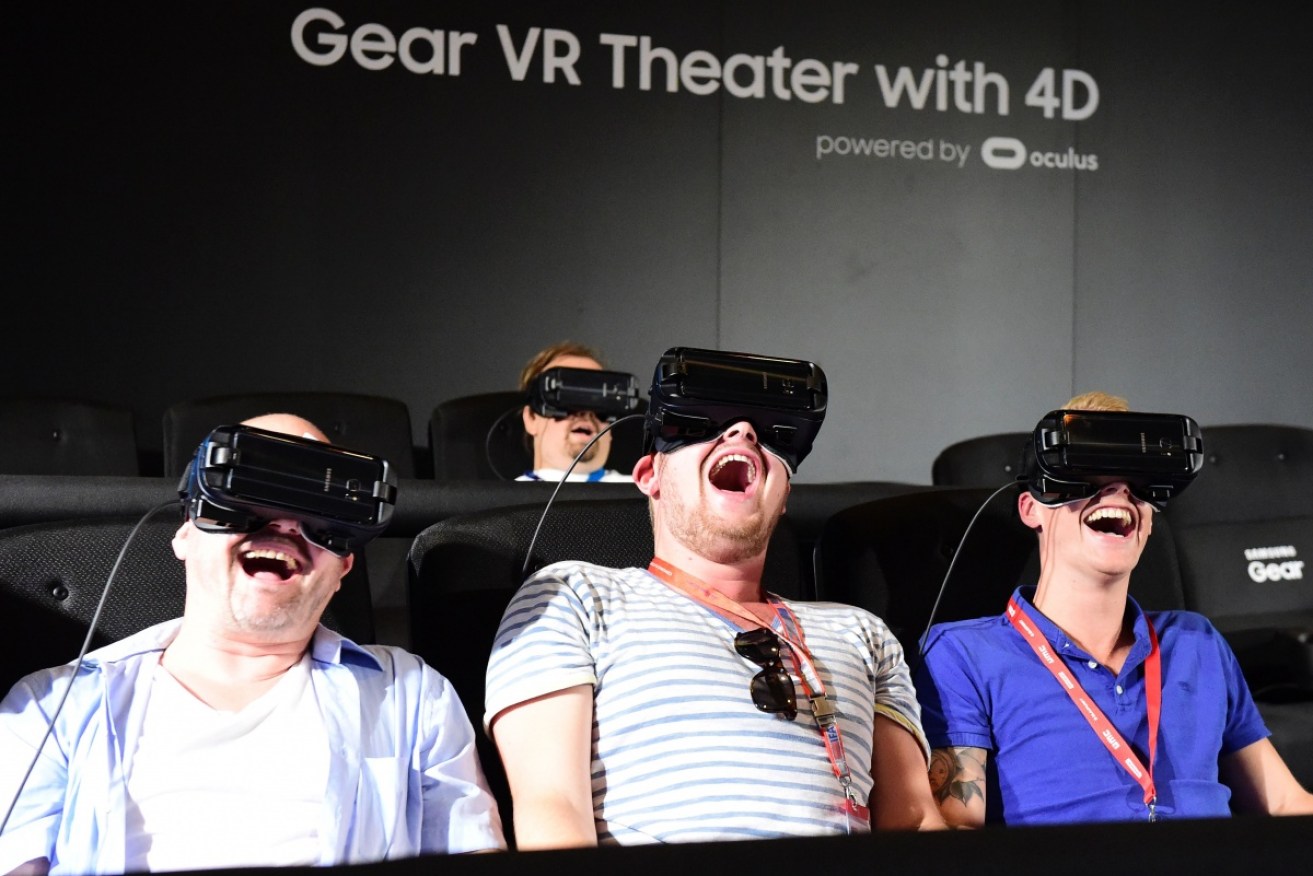How you can benefit from the Virtual Reality revolution


Photo: Getty
You may not have noticed it, but our world is fast becoming irrevocably changed by Virtual Reality.
Once just a dream of video gamers, the advent of smaller and more powerful electronic hardware has made Virtual Reality (VR) a modern reality that promises to revolutionise the way we do business, learn, entertain and socialise.
The release this year of premium VR headsets, such as Oculus Rift and HTC Vive, has been surrounded by the launch of a variety of cheaper devices, bringing VR into the reach of everyone.
A digital world of our own making
VR is the electronic creation of a world that replaces our own using digital video and audio elements. This world is viewed using any number of specialised headsets that cover the eyes.
VR can be a completely fabricated environment or a video recording of a real event; like a live music concert, sporting event or nature documentary.
Some VR environments can also be viewed in 360 degrees, allowing us to look around as we would in the real world.
Shining a light on loneliness, sadness and suffering
Alongside the thrill and novelty of VR comes the potential to take us on an emotional journey, engaging us in the narrative, encouraging empathy and inviting us to make choices that affect our story.
Companies like Medibank are developing projects just like this, such as the VR application, Joy.
Designed to alleviate the feelings of loneliness and isolation felt by some hospital patients, this storytelling app transports patients to a world of virtual ‘friends’, all sitting around a campfire, to listen to a variety of stories. See below:
Highlighting the plight of refugees the world over, the UN has created a VR film that follows a 12-year-old Syrian girl as she navigates a bloody camp filled with 84,000 refugees.
Titled Clouds Over Sidra, the experience is breathtaking and powerful, placing the viewer next to Sidra as she explores the camp, and witnesses the lives of only a handful of the millions of refugees escaping the Syrian civil war.
Closer to home, Collisions is a VR journey into the lives of Indigenous Australians affected by nuclear testing in the South Australian desert, created by filmmaker Lynette Wallworth for ACMI, in Melbourne.
Immersive and compelling, the tale of Aboriginal elder, Nyarri Nyarri Morgan, explores his community’s approach to caring for the planet and the long-reaching, sometimes harmful, effects of modern technology.
https://www.youtube.com/watch?v=8T05bNegL7M
As much as these applications have the capacity to create impact on a humanitarian level, VR has also given us new ways to create and share our own stories, art and ideas.
Australia recently played host to its first Tilt Brush tournament, held at Virtual Reality arcade, VR Corner, in Sydney.
Tilt Brush is a virtual painting application, where painters wear VR headsets and set about creating 3D works of virtual art using special controllers; literally creating art from thin air.
The program is now finding regular use with a variety of artists; from painters and sculptors, to fashion designers and street artists.
Sentient Flux is another groundbreaking project. Half interactive artwork, half mindfulness exercise, viewers find themselves enveloped in a swarm of glowing particles that respond to motion like a cloud of inquisitive insects.
Creator Nicola Plant got the idea for Sentient Flux after “snorkelling in Cambodia with phosphorescent plankton.”
After obtaining a VR headset development kit, Plant “wondered what would happen if it could be recreated, but the glowing particles actually respond sympathetically to you”. The result is mesmerising and calming.
With the opportunity to create immersive games, entertainment and healthcare applications, alongside powerful and compelling narratives, the future of VR looks extremely promising.
Augmented Reality: More than the real world
Sitting slightly behind VR is the development of Augmented Reality (AR) – a system that inserts digitally generated elements, like audio, graphics and video, into the real world.
Right now you can experience simple forms of AR, using your smartphone camera and a simple app, such as the Ikea Catalogue app.
Simply hold up your smartphone to see the room before you on the screen, then digitally place furniture where you like to get an idea of how it will look.

Ikea’s Catalogue app lets you decorate your home without buying a single item of furniture.
On a grander scale, Google made a recent foray into the world of AR, with Google Glass – a pair of smart glasses that inserted audio and graphic elements into the wearer’s field of view.
Despite yielding many lessons for the technology giant, Glass was not successful.

Google Glass was not as big a success as first hoped. Photo: Getty
However, a new AR intiative by Microsoft is generating new excitement in a variety of industries, particularly medical and industrial design.
Say hello to HoloLens – a headset that allows a user to interact with digital elements in the real world, in real time.
Imagine a surgeon being able to perform complicated emergency surgery with the help of a doctor on the other side of the globe, who is digitally standing next to them; or a city planner walking through a derelict industrial estate as structures around them are digitally replaced with newly designed apartment buildings.
This is all possible in AR.

The Microsoft HoloLens allows you to interact with digital elements in the real world.
Once available on a wider scale and at a consumer-friendly price, devices like HoloLens will usher in the era of the true digital personal assistant.
In much the same way that we currently call up Siri, Cortana or OK Google with a voice query, a HoloLens assistant will appear virtually before you, digitally inserted into your world, and offer information and assistance on a variety of tasks.
For an idea of what that might look like, check out this video, made using HoloLens.
While HoloLens is still some way off, the applications for such devices are limited only by our imagination.
https://www.youtube.com/watch?feature=youtu.be&a=&v=2q6P3Kv91JU
Getting started
The good news is, you don’t have to throw a thousand dollars or more at a premium VR headset to jump straight in today.
There are many cheap alternatives – like Google Cardboard – that will allow you to roam museums from a distant country or explore the far reaches of space, or inner space, from the comfort of your own home.
Many commonly available VR headsets will require a smartphone to be inserted inside the headset to display content through specially designed lenses that sit in front of the eyes.
Some headsets may include integrated audio headphones, but many require you to connect a headset to your smartphone for the complete experience.
A variety of VR smartphone apps and games are now available to download from the Google Play or iOS App Store. Simply download the app to your phone, insert your handset into your headset and follow the app instructions.
The best smartphone apps
If you’d like to dip your toe in the vast digital ocean of VR, here’s a selection of smartphone apps to get you started:
The Museum of Stolen Art VR
Android, iOS
Browse a virtual art gallery containing works of art currently lost in time.
Within
Android, iOS
Curated VR and 360-degree videos from a across the worlds of Art, nature and media.
InCell VR
Android, iOS
See the human body like never before in this cellular exploration.
Chair in a Room
Android
Prepare to lose a little sleep over this glimpse into the future of VR horror games.
Jaunt VR
Android, iOS
Journey to the furthest reaches of the planet with these groundbreaking documentaries.
SBS VR
Android, iOS
Unique stories, told in VR and 360 degrees, from around the planet.
Note: some apps may require a controller to navigate content.
The best headsets
Oculus Rift + Touch
$1399
The pinnacle of premium VR, the Rift headset sports a high-resolution display, integrated audio and comprehensive motion tracking for total immersion into a virtual world. Stay tuned for a second generation Rift in 2017.
360fly VR Headset
$69
The dual, adjustable lens system of the 360fly headset means you don’t need to wear your glasses to enjoy all the 360-degree video you shot earlier that day. Turn footage into a VR experience with the push of a button.
View-Master Deluxe VR Viewer
$49.99
If you grew up with a View-Master slideshow viewer, this digital-age, VR equivalent is just the thing for you. Download the View-Master app to your smartphone and insert it into the headset for the next level of nostalgic fun.
ZEISS VR One Plus
$199.95
With famous Zeiss optics, this VR headset can be used with smartphones between 4.7 and 5.5 inches in size and will even allow you to wear your own prescription glasses underneath.
Google Daydream View
$119
Comfortable and lightweight, Google’s VR headset – to be used with the company’s new Pixel smartphone – comes with a Bluetooth controller to easily control apps and games.
HTC Vive
$1399
The Vive headset features a front-facing camera and 110-degree field of view; providing ‘next-level’ aumentation by way of real-world input, haptic feedback controllers and 360-degree motion tracking.
Samsung Gear VR
$159
In partnership with Oculus, this headset is dedicated for use with Samsung Galaxy S6, S7 and Note5 devices, and features built-in controls to make app and game navigation a cinch.
PlayStation VR
$549.95
The first dedicated headset for a gaming console, the recent launch of PSVR came with dozens of supported games – kicking off the console VR war in premium style and performance.
Alcatel Vision
$899
Featuring a built-in processor and memory, sensors that measure position and proximity, and Bluetooth and Wi-Fi connectivity, the Vision is a wireless VR headset that you only need charge to enjoy two to three hours of HD VR immersion. Coming soon.
Google Cardboard
From $15
A literal piece of cardboard that folds into a simple VR viewer, Cardboard is a simple and fun approach to enjoying VR content – it’s low cost and easy assembly also makes it great for kids.


















